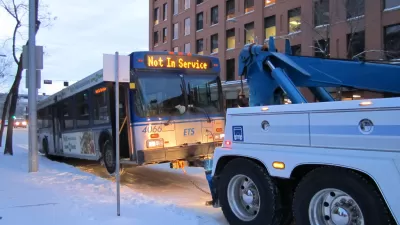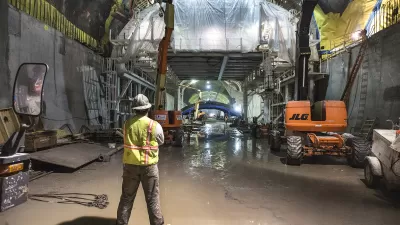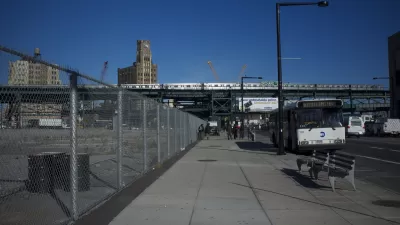In light of the resignation of APTA's president following the withdrawal of the New York Metropolitan Transportation Authority, the Transit Center offers its recommendations for reforming the national transit advocacy organization.

"APTA President and CEO Michael Melaniphy resigned late last month following news that New York’s Metropolitan Transportation Authority [MTA]—which carries 35 percent of the country’s transit riders—was withdrawing from the industry association," writes the TransitCenter.
In the [7-page] letter [PDF] announcing the agency’s decision..., MTA President Tom Prendergast implied that transit agencies in other large cities shared these sentiments. Prendergast described the agency’s “collective dissatisfaction with various aspects of APTA,” including the organization’s governance structure, its excessive membership dues, and Melaniphy’s annual compensation of nearly $900,000. [More reasons posted here].
TransitCenter, a New York City-based transportation research, advocacy and funding organization, views the vacancy as "an opportunity for APTA to move decisively in a new strategic direction."
The case for transit is stronger than ever, between the need to combat climate change through our transportation habits, the decline in driver’s license possession among young people, increased scrutiny of highway-building, and the prominence of socioeconomic inequality as a political issue.
Among TransitCenter's recommendations:
- Widen its leadership to "include advocates with expertise in poverty reduction, urban planning, and housing."
- Become less federally oriented (the group is based in D.C.) and more locally focused, e.g., "ensuring its members are effective advocates against auto-centric development policies."
Among the more controversial recommendations is to deal openly with what Planetizen called "half-baked" rail projects:
It’s hard for a membership-based organization to tell any of its members that they have an ugly baby. But let’s face it: some transit agencies propose (and build) projects that are functionally useless, bad value for money, or just inherently flawed.
State and federal leaders often hesitate to criticize local transit boondoggles for fear of jeopardizing a ribbon-cutting. That’s why APTA is in a uniquely powerful position to educate local officials about transit planning from the ground up, encouraging them to ask what ends they seek to achieve with transit rather than what a particular project should look like.
Finally, TransitCenter recommends that APTA align itself more with "biking and walking advocacy groups" and less with the "highway lobby."
Click here for past posts on TransitCenter.
Hat tip to Martine Powers of POLITICO Morning Transportation.
FULL STORY: The APTA Transit Needs

Planetizen Federal Action Tracker
A weekly monitor of how Trump’s orders and actions are impacting planners and planning in America.

San Francisco's School District Spent $105M To Build Affordable Housing for Teachers — And That's Just the Beginning
SFUSD joins a growing list of school districts using their land holdings to address housing affordability challenges faced by their own employees.

The Tiny, Adorable $7,000 Car Turning Japan Onto EVs
The single seat Mibot charges from a regular plug as quickly as an iPad, and is about half the price of an average EV.

Seattle's Plan for Adopting Driverless Cars
Equity, safety, accessibility and affordability are front of mind as the city prepares for robotaxis and other autonomous vehicles.

As Trump Phases Out FEMA, Is It Time to Flee the Floodplains?
With less federal funding available for disaster relief efforts, the need to relocate at-risk communities is more urgent than ever.

With Protected Lanes, 460% More People Commute by Bike
For those needing more ammo, more data proving what we already knew is here.
Urban Design for Planners 1: Software Tools
This six-course series explores essential urban design concepts using open source software and equips planners with the tools they need to participate fully in the urban design process.
Planning for Universal Design
Learn the tools for implementing Universal Design in planning regulations.
Smith Gee Studio
City of Charlotte
City of Camden Redevelopment Agency
City of Astoria
Transportation Research & Education Center (TREC) at Portland State University
US High Speed Rail Association
City of Camden Redevelopment Agency
Municipality of Princeton (NJ)




























